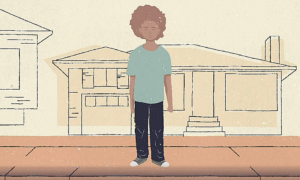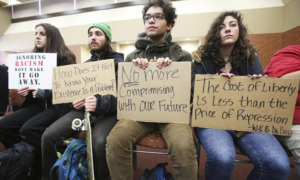Arizona State University Watts College of Public Service and Community Solutions
Youth in foster care face a multitude of barriers when it comes to higher education. How will they pay for room, board, books and tuition? Who will help them complete applications and other paperwork? And where will they live over the summer?
With so many unknowns, it’s no surprise that about 4 percent graduate from college by the time they’re 26, compared to 36 percent of the general population, according to some studies. (This is the most cited statistic nationally, though studies showing the college graduation rate among foster youth can say it’s 1 to 11 percent.)
Foster youth fall behind academically
Foster students are just as likely as their peers to have college aspirations, but only 32 to 45 percent pursue higher education after high school, according to a fact sheet by the Legal Center for Foster Care and Education (LCFCE). By comparison, about 67 percent of the general population enrolls in a college or university after graduating high school.
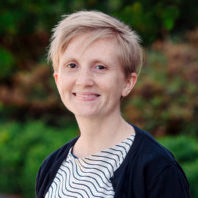
Washington State University
Amy Salazar
Researchers say one explanation is poor academic performance linked to youth in care frequently changing schools. On average, these students move to a different school one to two times every year, according to the LCFCE. All this bouncing around makes it nearly impossible to stay on track with coursework, says Amy Salazar, an assistant professor at Washington State University in Vancouver and director of its Foster Care Research Lab.
“When you switch schools, it’s not like every school is doing the exact same lesson,” explained Salazar, noting that students also lose contact with guidance counselors and teachers who might have influenced them to go to college. “You also are going to have less opportunities to do activities and extracurriculars that might help you get into college.”
Students who change schools at least once are less than half as likely to graduate high school as students who don’t change schools, according to a study by researchers at the University of California, Santa Barbara. That data aligns with national figures that show 58 percent of foster youth finish high school by age 18, compared to about 84 percent nationally.
Congress has tried to increase school stability for foster students by not requiring them to change schools whenever they change foster care placements. Instead, the originating school must pay to transport the students each day, sometimes with help from the local child welfare agency. Unfortunately this option isn’t always practical because of the length of the new commute.
“Technically, by law, they should be able to go to that school, but no one wants to spend three hours going to school every day,” Salazar said.
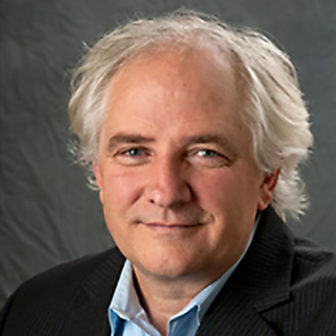
University of Chicago
Mark Courtney
When youth in foster care who are behind academically do pursue higher education, they are more likely to drop out because they aren’t prepared for college-level coursework, says Mark Courtney, a professor in the School of Social Service Administration at the University of Chicago and an expert on outcomes for children in foster care.
“Those kinds of educational challenges need to be addressed prior to entering college, or you’re going to have a hard time in college,” he said. “Depending on where we’re looking, 40 to 50 percent of youth transitioning out of foster care … go to college at some point between their 18th birthday and their 21st birthday, but very few of them are making the kind of progress they need to make to get a two-year degree, let along a four-year degree.”
Extending foster care
These students often take longer to graduate from college because they need to complete zero-credit remedial classes to catch up. They may also apply to college later because they need to pass the GED test if they didn’t complete high school.
Extending foster care eligibility is key to helping these students access higher education, said Amy Dworsky, a research fellow at Chapin Hall at the University of Chicago. By extending foster care to 21, she says young people are more likely to have an adult present who can help with the college process.
“How do you apply to schools? How do you decide which schools to apply to? How do you fill out the FAFSA form? Those are all things that parents typically help you with,” she said. “If young people are no longer in foster care when they’re 18 or 19 years old, who do they go to to help them?”

Chapin Hall
Amy Dworsky
Since 2010, at least 25 states and the District of Columbia have extended foster care eligibility from age 18 to 21 using federal funding from the 2008 Fostering Connections to Success and Increasing Adoptions Act. About 20 other states have policies in place to extend foster care beyond the age of 18, according to data from the Juvenile Law Center.
Staying in the foster care system not only makes it easier for students to seek guidance from adults, but also ensures they have stable housing, health care and other benefits. Still, most youth don’t apply to extend their foster status. Only about a quarter of 18-year-olds remain in foster care until their 19th birthday, according to a report from the Annie E. Casey Foundation.
Dworsky authored a multiyear study that compared students in Illinois — where youth routinely remain in foster care until their 21st birthday — to their peers in Iowa and Wisconsin. She found that students who extended their foster care were almost twice as likely to attend college, but were no more likely to complete a two- or four-year degree. Surveyed students said the main reason they dropped out of school was because they needed to work.
Expanding financial support
Programs to help youth in care pay for college are on the rise, but experts say many students aren’t informed about the options available to them.
One federal program is the Educational Training Voucher (ETV), which is part of the John H. Chafee Foster Care Independence Program. It provides up to $5,000 annually for college, training or career school. Legislation passed last year expanded the program’s eligibility criteria to let students apply until age 26, instead of 23.
States and colleges often provide their own financial assistance packages and scholarships as well. At least 23 states offer tuition waivers that can be used at public colleges or vocational schools within the state. One outlier is Connecticut, which allows students to spend their waivers at any institution of higher education, inside or outside the state. A handful of other states, such as California, Michigan, New York and Washington, offer other scholarships and grants to help youth in foster care pay for college and job training.
“A lot of these resources can be really hard to access,” Salazar said. “I was just looking at a list of scholarships and funding streams the other day. They all have different age limitations and application procedures … and it’s just so complicated. I have a Ph.D. and it would take me forever to do all that stuff.”
Breanna Carpenter, who was formerly a youth in care, says no one told her about Arizona’s tuition waiver program until the spring semester of her senior year in high school, when a Department of Child Safety worker came to speak with her.
“The poor man. He was so nice, but there was only one of him to cover our entire state,” recalled Carpenter, who is earning a master’s degree at Arizona State University. “When I was in care, our tuition waiver was a new thing that had just passed for a five-year pilot program, so a lot of people didn’t really know that it existed.”
She was ultimately awarded an Educational Training Voucher, academic scholarship and a private scholarship for foster youth. Even then, she says she worked between 15 and 30 hours a week on campus to make ends meet.
“I couldn’t just call up my mom and say, ‘Mom, I’m $50 short for a textbook,’” she said. “Even if you have money to cover all of the costs, you then don’t have money if your tire blows. There’s no emergency fund in case something happens.”
Reaching out to youth
In an ideal world, Dworsky says child welfare agencies should be hiring specialized caseworkers to prepare youth in care for higher education early on.
“This is something the child welfare agencies need to be doing. For too long it just wasn’t something they saw as their job. They may have thought it was the foster parents’ job. The foster parents may have thought it was the agency’s job. Young people just fell through the cracks.”
Some states and colleges are taking action to ensure foster youth know about their higher education options. Washington’s state-legislated Passport to Careers program includes funding for nongovernmental organizations to prepare students in foster care for college. The program, called Supplemental Education Transition Program (SETuP), helps teenagers with things like financial aid, college applications, course planning, transportation and housing.

Western Michigan University
Ronicka Hamilton
A handful of colleges have begun hosting summer programs to introduce foster youth to college life. The University of Alabama invites high school students to live in dormitories at its Tuscaloosa campus for a week and participate in activities like public speaking workshops, canoe trips and ACT Prep classes. The University of California, Los Angeles, has a similar three-day program for students entering ninth grade.
The Seita Scholars program at Western Michigan University tries to engage high school students by doing outreach in the community.
“There is stigma associated with having been in foster care, so going directly to high schools can be a little difficult,” said the program’s director, Ronicka Hamilton. To avoid embarrassing students, staff members give presentations about higher education during extracurricular functions for youth in care. They also reach out to foster care workers and education planners.
College programs for youth in foster care
The Seita Scholars program has been praised as one of the best for helping foster students attend and complete college. Named after John Seita, a former youth in foster care and WMU alumnus, the program assigns each student to a campus coach who is accessible 24 hours a day. Every coach must have a master’s degree and be clinically trained to work with youth in care. Participants also receive a scholarship that covers about 40 percent of costs, which they can combine with Pell Grants, ETVs and a Fostering Futures Scholarship from the Michigan Education Trust.
Another initiative that has received praise is California’s Guardian Scholars program. Launched in 1998, it offers foster students grants and scholarships that cover the full cost of tuition and living expenses. Participants also receive priority for on-campus and year-round housing, help with child care and extra supports like mentoring, career counseling and tutoring. At least 32 colleges in California offer a Guardian Scholars program or something similar.
Programs like these may be a reason students have better outcomes at four-year colleges, Courtney said. On-campus housing, mental health services and an immersive college environment are added benefits that community colleges — which foster youth are more likely to attend — don’t always provide.
“We have young people who are going to two-year colleges but really should be going to more selective schools,” he said. “The selectivity of the school you go to has everything to do with whether people persist over time and get a degree.”
More data is needed
Researchers say it’s heartening to see more states and colleges taking action to help youth in care succeed in school, but it’s hard to prove whether more of them are actually earning degrees. Most colleges have a small cohort of such youth, which makes it hard to gather reliable data.
“Most colleges don’t have hundreds and hundreds of former foster youth on them so that you would have the sample size you need. I think evaluating these programs is going to be quite a challenge,” Dworsky said.
Gathering data on college students in foster care has been difficult historically because many colleges don’t know which of their students spent time in care. One in four state-run colleges has no system to identify such students, according to a national survey released last year by the First Star Institute’s Foster Youth Success in College Project.
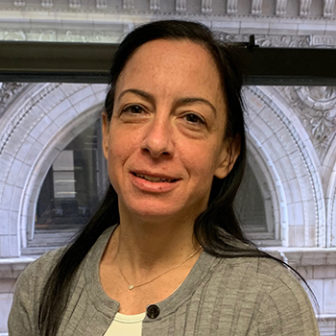
Juvenile Law Center
Jennifer Pokempner
“Having accurate data really helps you figure out how to serve the population,” said Jennifer Pokempner, senior attorney at Juvenile Law Center, a legal advocacy group in Philadelphia. “You can get some numbers from the FAFSA, but they’re not necessarily going to tell you who attending your school has a foster care experience.”
In an effort to tackle this problem, Salazar has developed her own pilot program for foster youth in southwest Washington state. Dubbed Fostering Higher Education, the program will recruit about 45 students who are in the spring semester of their junior year of high school (or earning a GED certificate) and track them for two years.
To create a randomized controlled trial, participants will be divided into three groups: one that receives intervention services, one that receives partial services and one that receives no extra services. Students who receive full services will have access to professional education advocates, take a course about pitfalls they may encounter while earning their degrees and meet one-on-one with adult mentors who have made it through college.
The pilot is scheduled to kick off early this summer. If it’s a success, Salazar says it will be one of the first programs of its kind with measurable results.
As a former youth in care, Carpenter says it’s disappointing to know most students like her won’t earn a college degree, but she believes things are changing for the better.
“Whether it’s higher education or not, setting youth up to be successful in adulthood is really important. We’re going to pay for it as a society, whether we want to acknowledge that we will or if we won’t,” she said. “It makes me really sad that [graduation rates are] so low, but … it also makes me really hopeful that we are talking about it and that people are fighting for it.”
This yearlong reporting project is made possible in part by The New York Foundling, which works with underserved children, families and adults with developmental disabilities. Throughout this project, Youth Today will maintain editorial independence.




